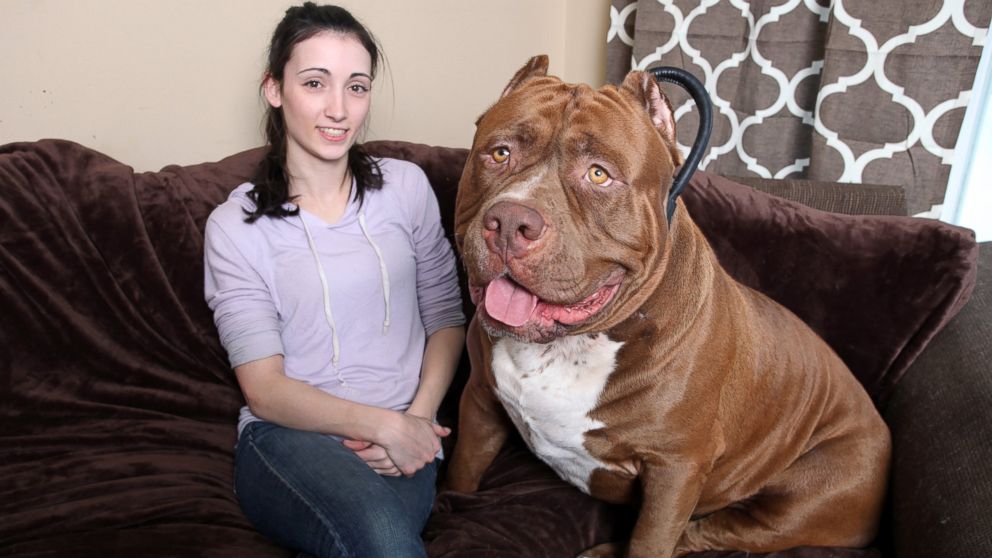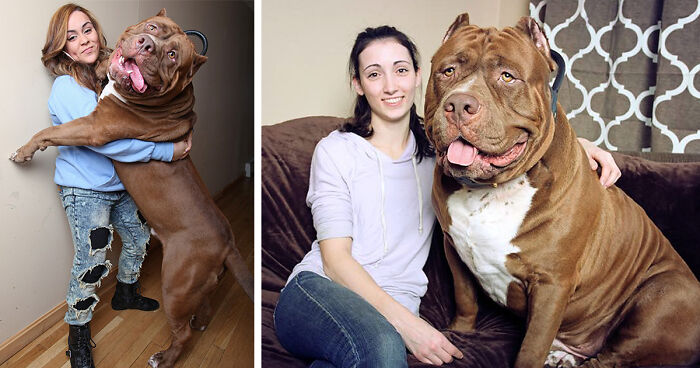Did you know that pitbulls can grow to be quite large? In fact, the size of a pitbull can vary greatly depending on various factors such as genetics and nutrition. While some pitbulls may be on the smaller side, standing around 17-20 inches tall at the shoulder, others can reach impressive heights of up to 27 inches or more.
Pitbulls are known for their muscular build and strong stature. The average weight of a pitbull can range from 30-80 pounds, with some exceptional individuals weighing even more. However, it’s important to note that proper care and a balanced diet are crucial in ensuring a healthy weight for pitbulls. Regular exercise and portion control can help prevent obesity, which can lead to various health issues. Understanding and responsibly managing the size of pitbulls can contribute to their overall well-being and quality of life.

How Big Can a Pitbull Get?
Pitbulls are a popular breed known for their strength, athleticism, and loyalty. Many dog enthusiasts wonder about the potential size of this breed. In this article, we will explore the factors that influence the size of a pitbull, provide information about their average height and weight, and discuss the variations within the breed.
1. Genetics and Breeding
The size of a pitbull is primarily determined by its genetics and breeding. Like any other breed, pitbulls inherit physical characteristics from their parents. Breeders typically aim to produce pitbulls that adhere to specific standards, which include size. They carefully select parent dogs based on their desired traits, including height and weight. However, it’s important to note that even within a litter, there can be variations in size due to genetic factors.
The American Pitbull Terrier, one of the most popular types of pitbulls, usually stands between 17 to 21 inches tall at the shoulder and weighs between 30 to 60 pounds. However, variations can occur depending on the specific bloodline and breeding. It’s essential to choose a reputable breeder who focuses on producing healthy and well-structured pitbulls.
Additionally, mixed breeds that include pitbulls may have different size ranges due to the influence of other breeds. Genetic diversity can introduce variations that make it difficult to predict the exact size of a mixed breed pitbull.
2. Nutrition and Exercise
Nutrition and exercise play crucial roles in the growth and development of pitbulls. Providing the right amount of high-quality food is essential to support their growth. Puppies require a nutrient-rich diet to ensure proper bone and muscle development. As they mature, it’s important to monitor their food intake to prevent excessive weight gain, which can negatively impact their health and predispose them to certain health conditions.
Just like any dog, pitbulls need regular exercise to maintain a healthy weight and build strong muscles. Regular physical activity, such as walks, playtime, and runs, is crucial to prevent obesity and promote overall well-being. Exercise also helps to stimulate their minds and prevents boredom, which can lead to destructive behaviors. However, it’s important to avoid excessive exercise during the early growth stages to prevent potential joint and bone problems.
Consulting with a veterinarian to determine the appropriate diet and exercise routine for your pitbull is highly recommended. They can provide personalized recommendations based on your dog’s age, size, and activity level.
3. Gender and Age
Gender and age can also impact the size of a pitbull. Generally, male pitbulls tend to be slightly larger and heavier than females. However, individual variations within the breed are considerable, and there can be exceptions to this generalization.
As pitbulls age, they go through growth spurts and reach their full physical maturity at around two to three years old. During this time, their height and weight will stabilize. It’s essential to provide proper nutrition and monitor their growth during this period to ensure they develop to their full potential.
It’s important to note that while size is a notable aspect of a pitbull, it’s essential to focus on their overall health, temperament, and suitability for your lifestyle when selecting a pet. Factors such as temperament, training, and socialization are equally important aspects to consider when bringing a pitbull into your home.
Tips for Owning a Pitbull
Owning a pitbull comes with specific responsibilities. Here are some essential tips to keep in mind if you are considering adding a pitbull to your family:
1. Proper Training and Socialization
Pitbulls are highly intelligent dogs, and they thrive when given proper training and socialization. To encourage good behavior and prevent any potential aggression issues, it’s crucial to start training and socialization from a young age. Enroll your pitbull in obedience classes and expose them to various people, animals, and environments to ensure they become well-rounded and confident dogs.
2. Regular Exercise
Pitbulls are energetic and require daily exercise to expend their energy. Regular walks, playtime, and interactive toys are essential to keep them physically and mentally stimulated. Lack of exercise can lead to boredom and may result in destructive behavior.
3. Proper Nutrition and Health Care
Providing a balanced, nutritious diet is important to keep your pitbull in good health. Consult with your veterinarian to determine the best food options for your dog’s specific needs. Regular veterinary check-ups, vaccinations, and preventive care are also critical to maintaining their overall well-being.
4. Responsible Ownership
Pitbulls have faced negative stereotypes over the years, making responsible ownership even more important. Ensure your pitbull is well-behaved, properly trained, and always kept on a leash when in public. Following local laws and regulations regarding pitbull ownership is crucial to ensure the safety of your dog and others.
Common Misconceptions About Pitbulls
Pitbulls often face unjust stereotypes due to misconceptions about the breed. Here are some common myths debunked:
1. Pitbulls are Inherently Aggressive
Contrary to popular belief, pitbulls are not inherently aggressive. Aggressiveness in dogs is primarily influenced by their upbringing, training, and socialization. Properly raised and trained pitbulls can be loving, loyal, and gentle companions.
2. Pitbulls Have Locking Jaws
Another common myth is that pitbulls have locking jaws. This is simply not true. Pitbulls have the same kind of jaw structure as any other breed of dog. Their powerful bite force is a result of their muscular build, not a unique anatomical feature.
3. Pitbulls Cannot Coexist with Other Pets or Children
Pitbulls can coexist peacefully with other pets and children when properly trained and socialized. In fact, they can form strong bonds with their human and animal family members. Early socialization and gradual introductions are crucial to ensure positive interactions between pitbulls and other pets or children.
4. Pitbulls are a Dangerous Breed
Labelling pitbulls as a dangerous breed is unfair and unfounded. It’s important to remember that any dog can display aggressive behavior if not properly cared for, trained, or socialized. Breed-specific legislation and policies that discriminate against pitbulls are not based on scientific evidence and overlook individual temperament and behavior.
Rescue Pitbulls: A Loving Choice
If you’re considering adding a pitbull to your family, don’t overlook the option of adopting from a rescue organization or shelter. There are many wonderful pitbulls in need of loving homes. Adopting a rescue pitbull not only provides them with a second chance at a happy life but also helps combat the negative stereotypes surrounding this breed.
In Summary
Pitbulls can vary in size, influenced by genetics, breeding, nutrition, exercise, gender, and age. Responsible ownership, training, and socialization are key to raising a well-behaved and loving companion. Remember, size should not be the sole criterion for choosing a pitbull. Providing a loving, supportive environment is ultimately the most important factor for a happy pitbull.
Key Takeaways: How Big Can a Pitbull Get?
- Pitbulls can vary in size, with males typically being larger than females.
- On average, pitbulls can weigh between 30-60 pounds (13-27 kg).
- Some pitbulls can grow to be as heavy as 80 pounds (36 kg) or more.
- Their height usually ranges from 17-21 inches (43-53 cm) at the shoulder.
- Proper nutrition and exercise play a key role in a pitbull’s growth and overall size.
Frequently Asked Questions
Welcome to our FAQ section, where we answer some common questions about the size of Pitbulls. Find out interesting facts about their growth and development.
What factors determine the size of a Pitbull?
The size of a Pitbull can vary depending on various factors such as genetics, diet, exercise, and overall health. Since they are a mixed breed, their size can be influenced by the traits of their parent breeds. Generally, males tend to be larger than females. Proper nutrition during their growth stages and regular physical activity can also contribute to their overall size and muscular development.
It’s important to note that while genetics play a significant role, individual variation can occur within litters, resulting in puppies of different sizes despite having the same parents.
At what age do Pitbulls stop growing?
On average, Pitbulls stop growing between 12 to 18 months of age. During this time, they will experience their main growth spurt, both in height and weight. However, it’s worth mentioning that some Pitbulls may continue to fill out and gain muscle mass until they reach around 2 to 3 years old.
It’s crucial to provide them with a balanced diet and exercise routine during this period to support their growth and ensure they develop into healthy adult dogs.
What is the average size of a fully grown Pitbull?
The average size of a fully grown Pitbull can vary depending on their gender. Male Pitbulls typically stand between 18 to 21 inches (45 to 53 cm) tall at the shoulder and weigh between 35 to 65 pounds (16 to 29 kg). Female Pitbulls, on the other hand, tend to be slightly smaller, standing between 17 to 20 inches (43 to 50 cm) tall and weighing between 30 to 50 pounds (14 to 23 kg).
It’s important to remember that these measurements reflect the general range and individual Pitbulls can fall above or below these averages based on various factors.
Can Pitbulls grow bigger than the average size?
Yes, it is possible for some Pitbulls to grow bigger than the average size. Factors such as genetics, nutrition, and exercise can influence their growth potential. Some Pitbulls, known as “XL” Pitbulls, have been selectively bred to be larger in size, surpassing the traditional standards. However, it’s important to note that these XL Pitbulls are not recognized as a separate breed by kennel clubs and organizations.
If you are considering a larger Pitbull, it’s essential to research and find responsible breeders who prioritize the health and well-being of their dogs.
Are there any health concerns related to the size of Pitbulls?
While Pitbulls can vary in size, it’s important to note that extreme sizes can sometimes come with their own set of health concerns. Overly large Pitbulls may be prone to joint issues, such as hip dysplasia, and can be more susceptible to certain health conditions. It’s crucial to ensure that the Pitbull’s size is within a healthy range and not detrimental to their overall well-being.
Regular veterinary check-ups, a balanced diet, and a suitable exercise routine can help maintain a Pitbull’s health regardless of their size.

The BIGGEST PITBULL In The World
Summary
So, how big can a pitbull get? Well, the size of a pitbull can vary depending on factors like genetics and care. On average, though, a fully grown pitbull can weigh anywhere between 30 to 70 pounds and stand around 17 to 20 inches tall. It’s important to remember that not every pitbull will grow to be massive, and each dog is unique.
Now, there are different types of pitbulls, such as American Staffordshire Terriers and American Pit Bull Terriers, and their sizes might differ slightly. Also, a pitbull’s growth rate can slow down after one year, so they may not keep getting bigger after that. Remember, the most important things are to give your pitbull proper nutrition, exercise, and love, regardless of their size.
